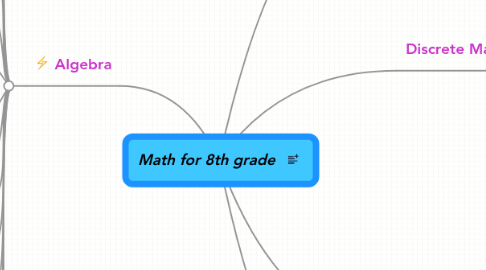
1. Algebra
1.1. 8.2.1.1
1.1.1. Algebraic representations
1.1.1.1. Use algebraic concepts and processes to represent and solve problems that involve variable quantities.
1.2. 8.2.1.2
1.3. 8.2.1.3
1.4. 8.2.1.4
1.5. 8.2.2.1
1.6. 8.2.2.2
1.6.1. Equations and inequalities
1.7. 8.2.2.3
1.8. 8.2.2.4
1.9. 8.2.2.5
1.10. 8.2.3.1
1.10.1. Variables, Expressions and Operations
1.10.1.1. Analyze the interaction between quantities and/or variables to model patterns of change.
1.11. 8.2.3.2
1.12. 8.2.4.1
1.13. 8.2.4.2
1.14. 8.2.4.3
1.14.1. Patterns, Relations and Functions
1.14.1.1. Recognize, describe and generalize patterns and build mathematical models to make predictions.
1.15. 8.2.4.4
1.16. 8.2.4.5
1.17. 8.2.4.6
1.18. 8.2.4.7
1.19. 8.2.4.8
1.20. 8.2.4.9
2. Numbers and Operation
2.1. 8.1.1.1
2.1.1. Number sense
2.1.1.1. Develop an understanding of numeration systems and their properties
2.2. 8.1.1.2
2.2.1. Number Operation
2.2.1.1. Understand the operations and apply them to solve problems.
2.3. 8.1.1.3
2.3.1. Estimation
2.3.1.1. Develop operation sense, and use it to estimate results of operations.
2.4. 8.1.1.4
2.4.1. Ratios and Proportional Reasoning
2.4.1.1. Develop an understanding about numbers, their magnitude and their relationships.
2.5. 8.1.1.5
2.5.1. Properties of numbers and Operations
2.5.1.1. Translate among equivalent forms of numbers to facilitate problem solving.
3. Data Analysis & Probability
3.1. 8.4.1.1
3.1.1. Data representation
3.1.1.1. Standard 3 - Data investigation
3.2. 8.4.1.2
3.2.1. Characteristics of data sets
3.3. 8.4.1.3
3.3.1. Probablility, experiments and samples
3.3.1.1. Standard 4 - Probability, randomness and uncertainty
4. Geometry and Measurement
4.1. 8.3.1.1
4.1.1. Relationship between geometric figures
4.1.1.1. Use transformations and concepts of location, relative position and symetry to visualize, represent and verify geometric relationships.
4.2. 8.3.1.2
4.2.1. Dimension and Shape
4.2.1.1. Recognize, describe and model shapes and relationships and represent and rason about them in increasingly abstract ways.
4.3. 8.3.1.3
4.4. 8.3.2.1
4.4.1. Position and direction
4.5. 8.3.2.3
4.5.1. Mathematical Reasoning
4.5.1.1. Use measurement to make the connection between number and space in order to describe, analyze and represent real-world and abstract situations.
